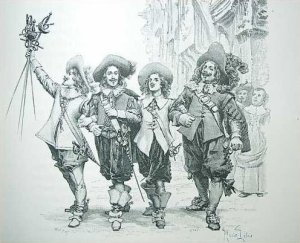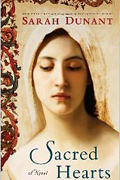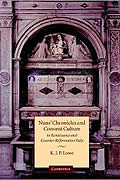BOOK REVIEW
Nuns’ Chronicles and Convent Culture in Renaissance and Counter-Reformation Italy by K. J. P. Lowe
CUP: Cambridge, 2003; ISBN: 9780521621915; 454 pp.; Price: £83.00.
Sacred Hearts by Sarah Dunant
London : Virago, 2009; ISBN 9781400063826; 432 pp.; Price: £8.99.
Reviewer: Caroline Bowden (Queen Mary, University of London)
The challenge in writing a comparative review of Kate Lowe’s fine study of early modern Italian convents Nuns’ Chronicles and Convent Culture with Sarah Dunant’s gripping novel Sacred Hearts is to find ways of making sense of the experience of reading both beyond stating the obvious. They are both about the religious life ofwomen in a particular time (early modern) and in one country (Italy). They are both well worth reading for entirely different reasons, but I think few people (apart from this reviewer) are likely actively to enjoy reading both: most readers will, I suspect, choose to read one or the other. Having made a brief survey of online discussions of historical fiction, it is clear that there is a huge readership for historical fiction and some well-crafted reviews of historical novels of all periods. At the same time it seems to me that there is a degree of misapprehension among the contributors to these sites about the ways that historians work and write, with repeated emphasis on their opinion that historians research to ascertain the facts which they then write up in narratives. Probably with the recent increasing interest among historians in commenting on historical fiction there will be similar misunderstandings coming from the other direction. We all need to be aware of the debates if we are to appreciate how each contributes to our understanding of the past.
In the case of this pair of books, Sarah Dunant’s novel relies heavily on Lowe’s research: her heroine, the apothecary (who saves the newly arrived Serafina from a life of incarceration) is closely modelled on the family circumstances of the Chronicler from S Cosimato in Rome. Both their fathers had medical qualifications. Perhaps coincidence, but it is part of the novelist’s skill to turn such trifles into significant elements in their story telling. The plot and indeed many of the relationships in the convent are governed by Dunant’s acceptance of Lowe’s argument that in Italian convents of the period a majority of entrants were placed there against their will and negotiating a way out was virtually impossible. Given the number of convents in early modern Italian cities, this suggests that a large proportion of aristocratic women were incarcerated for life. Much of the subtlety of characterisation of the fictional members of Santa Caterina is dependent on acceptance of this argument and the ways that individuals came to terms (or failed to do so) with forced professions. Dunant’s novel effectively recreates the atmosphere of an enclosed space, governed by extraordinarily complex rules and with the added tension created by office holders working out their own strategies for achieving grace. However, I think it is important to point out that the detailed research to support this argument does not form part of Lowe’s study. Certainly young women and even a few small children were placed in the convents for a variety of reasons and remained there for long periods of time with little choice about staying or leaving. Further research is needed to identify individual life experience in the convents to support more definite conclusions about the numbers involved.
I have to confess that I am not a reader of historical fiction by choice, but in this case I found myself drawn into the life of Serafina with her beautiful voice and her travails in the Ferraran convent, where her profession was forced on her because she had fallen in love with her music teacher and the family wished to separate them and focus on her younger sister’s marriage instead. Serafina finds it impossible to accept her enclosure and the story reveals how she gains support from a few nuns in the community in her struggle. Dunant creates a very real sense of the claustrophobic atmosphere of the restricted space, occupied by women governed by regulations affecting every part of their life, many of whom had not chosen to be there. Is it significant that there has been a change in the cover design? For some editions there is a rear view of a cloaked figure moving towards a dark doorway: there is now an attractive young woman with a low(ish) cut dress, eyes modestly cast down. This version gives no clues about the convent setting of the novel. The book does now advertise discussion points: my edition did not so I cannot comment on their value for teaching purposes. Their target audience was more likely to be readers in book groups.
Sarah Dunant brilliantly conjures up the atmosphere in a single convent for a small group of members. She has absorbed the detail provided by Lowe’s meticulous study to take the reader with her behind the walls. By contrast with the novel, Lowe is working on a much larger canvas to present an overview of three significant urban convents in the period as revealed in the chronicles written in the 16th century. Because of her own detailed knowledge of the sources and the period, Lowe is able to move confidently across three very different sources and convents. Such movements present challenges to the reader especially as the cultural context which clarifies some of the early material appears later in the book.
What are we to make of the central themes of these books: that of forced professions and the negative impact of male-instituted reforms? As someone who has spent a number of years studying the experience of female religious life in the early modern period, it is the denial of free will and choice to a substantial proportion of members of convents, who are in reality the inmates of a locked institution, which is shocking. Lowe argues too that Tridentine reforms were almost wholly negative in their impact on the convents. At S Cosimato for instance ‘life after Trent was merely a more severe version of an already very restricted lifestyle…’ The ‘nuns lost their opportunity to take decisions for themselves’ and their independence was repressed.(1) However if we look at the English convents with which I am more familiar, their foundations were made after Trent and neither they nor we as historians are in a position to compare life before and after. They had to accommodate the rules established by Trent and attract candidates in difficult circumstances and they created cultural and religious centres of some importance. In the English convents in exile, care was taken to ensure that women entered convents of their own free will and evidence has survived from many of the convents showing that candidates could, and in fact did, leave if they changed their mind about joining. They attracted patronage, constructed and decorated buildings in much the same way as their Italian counterparts in the earlier period described by Lowe.
The 16th century saw significant changes for women religious, largely as a result of Tridentine decrees which imposed enclosure and which are seen (as I have already suggested) by Lowe as negative in their impact on women. In fact as she shows, the reforms at Le Vergini in Venice pre-dated Trent in ending an unusual version of the religious life which permitted considerable freedom to the Canonesses who lived there. Perhaps it is the contrast between the latitude experienced there before 1519 to the forced professions described elsewhere in the study and in the novel which makes the incarcerations so notable. Reactions to enclosure did vary elsewhere. For instance, some writers in the new English convents founded in exile on the continent from 1598 even embraced enclosure, commenting how they welcomed separation from the secular world and the opportunities it provided to focus on their religious life without distractions. Perhaps it was different for them having experienced religious persecution and having to make a personal commitment to go overseas to join a convent. It was also not so hard as it was in Italy for them to leave if they were unsuited to the religious life. Such differences of female experience serve to demonstrate the importance of working comparatively as historians to take into account variations of circumstances.
It was good to read the bold conclusion by Kate Lowe emphasising the cultural significance of the Italian convents that formed her study and in particular their contribution to history writing. While, as she argues, their works were little known outside the convents at the time, ‘convent histories enter the mainstream of historical debate’.(2) Equally the success of Sarah Dunant’s book and her wide readership introduces a new group of readers to thinking and talking about a hitherto closed world.
1 Lowe, pp. 393, 394.
2 Lowe, p. 397.










 We have collected various opinions from staff who work in the IHR about what historical fiction means to them. What is their favourite historical novel and why? How do they view fictional writings when researching the past?
We have collected various opinions from staff who work in the IHR about what historical fiction means to them. What is their favourite historical novel and why? How do they view fictional writings when researching the past? Over the last month Dr Matt Phillpott has published on the
Over the last month Dr Matt Phillpott has published on the 

